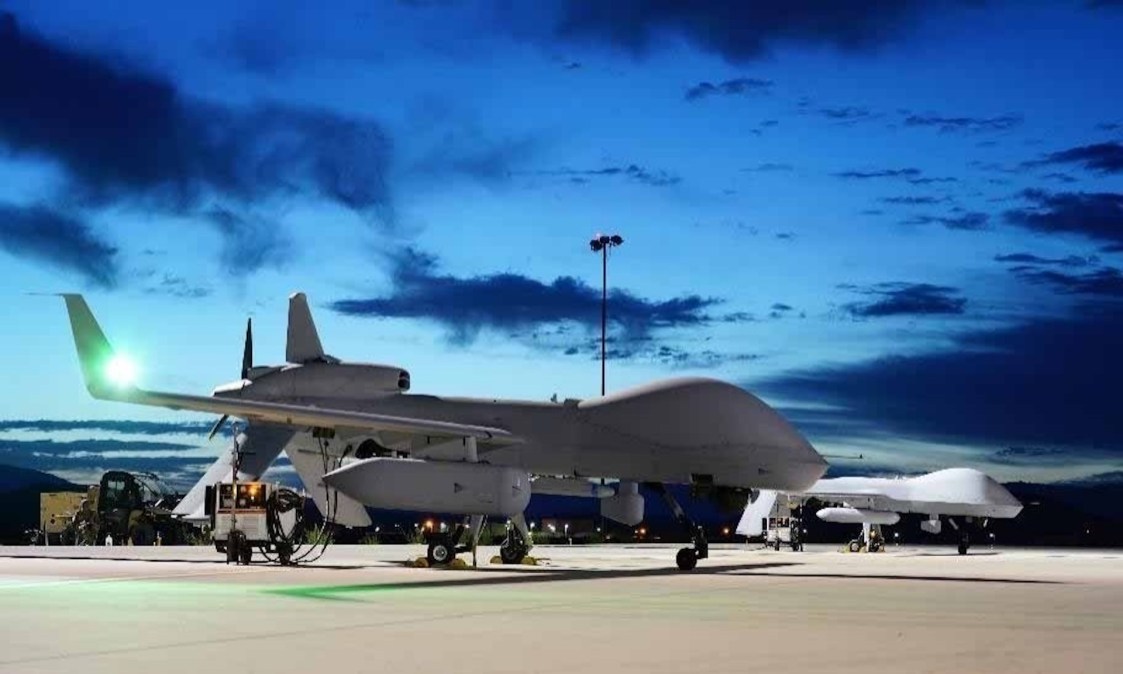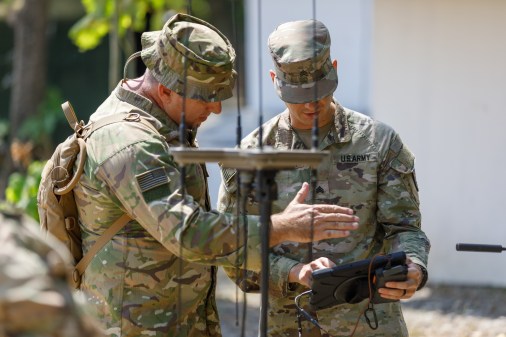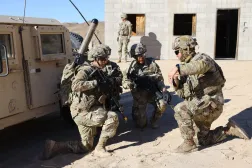Army moving on from MFEW aerial jammer, embracing backpack as ground-based solution

After almost a decade in the making, the Army is pivoting from its airborne electronic jammer, among other changes to the service’s electronic warfare offerings, according to a top official.
The service has decided to move on from the current Multi-Function Electronic Warfare Air Large (MFEW-AL) platform and approach. MFEW is the Army’s only airborne electronic warfare — with limited cyber — capability organic to combat aviation brigades to support maneuver commanders on the ground. The Lockheed Martin-made technology is a pod-mounted capability on a MQ-1C Gray Eagle drone, though officials have noted it was designed to be platform agnostic — provided the platform had the right power requirements.
The Army began developing the requirements and acquisition effort for MFEW over 10 years ago, awarding Lockheed the contract in 2019. The program has faced steep challenges for years with the department zeroing out procurement funding in its fiscal year 2022 budget. Following that decision, Army leaders sought to demonstrate that the service could make the system work in a variety of environments, especially considering the persistent need for aerial electronic attack.
Officials continued to maintain that following the zeroing out, the Army was making progress and the technology would be a critical enabler for multi-domain operations, even projecting it would equip the first unit with it in fiscal 2026 following initial operational test and evaluation.
The Army now wants to look at alternatives, either from the other services or the commercial sector, pivoting away from the MFEW platform as it exists currently, Brig. Gen. Wayne “Ed” Barker, program executive officer for intelligence, electronic warfare and sensors, said in a series of interviews.
Barker and his team briefed the changes to Congress last week.
“We’re pivoting to a more incremental approach focused on some of the existing capabilities that are out there with either sister services or other entities … within the EW space and trying to baseline what’s out there — and then [examine] what would it take to grow to meet the requirements from an MFEW standpoint,” he said. “The challenge will always be, and the Army acknowledges, the fact that we’re going to have the demand for aerial EA. And it’s [a question of] how do we close that gap?”
The problem, according to Barker, was when MFEW began, the Army didn’t necessarily have all the acquisition authorities it does now such as other transaction and middle tier of acquisition.
Over a decade ago, when the capability development document was finalized, MFEW was locked in and the Army didn’t have the latitude to learn, according to Barker.
That old mentality of locking in strategies and capabilities meant that the system was based on technology and threats with uncertain futures.
“When something has a degree of uncertainty and you try and codify it and then you’re not allowed to iterate and make adjustments, if any of that uncertainty or the risk of the uncertainty is realized, then it really can impact you,” Barker said. “What happened was so much of the uncertainty from a technology standpoint and the threat was realized, and without the mechanisms from a contractual standpoint or a requirement standpoint to pivot based on those changes, it just was not in an optimal position to be successful.”
Electromagnetic spectrum technologies and concepts have rapidly evolved over the last 10 years, leading the Army to now desire a more rapid approach and agile funding to be able to adjust in near real-time to the environment that is primarily software-based.
The initial requirement and capability for MFEW was all-encompassing, which has proven to be problematic now. The Army has instead opted for a more iterative and needs-based approach to requirements, issuing what it dubs “characteristics of needs” documents that are just a couple of pages of broad-based wishes for capabilities that industry can respond to rather than hundreds of pages of prescribed requirements.
As it stands right now, the current capabilities aren’t meeting the needs for MFEW.
Part of the discussion is framed around how the Army itself if evolving. Just over a month ago, the service unveiled a sweeping transformation initiative to become leaner and more agile. As part of the plan, it will no longer be procuring Gray Eagle drones and it will be divesting of some combat aviation brigades, which were key to MFEW.
Sensors, to include electronic attack capabilities, can now be strapped onto small and attritable drones that are significantly cheaper and easier to operate than larger, more exquisite systems.
As such, Barker said the Army isn’t totally starting from scratch with MFEW, noting officials are going to “leverage other people’s work” and take a more iterative approach to grow into something on the electronic attack front that can meet the Army’s requirement that still remains for aerial EA.
The old MFEW approach is much different than how the Army sought to build its Terrestrial Layer System-Brigade Combat Team (TLS-BCT) capability, which was devised roughly six years ago and awarded to Lockheed in 2021. It was an integrated electronic warfare, signals intelligence and cyber platform and had been described as a key enabler of Army priorities — considering the service has been without a program-of-record jammer for decades — that will support multi-domain operations.
The Army used middle tier of acquisition and other transaction authority for that program. About a year ago, it decided to alter its initial approach to TLS-BCT, which was envisioned to first to be mounted on Strykers and then Army Multi-Purpose Vehicle variant prototypes. The Army decided last year to split up those functions.
Outside experts had always voiced concern with such a setup given the highly classified nature and authorities that come with signals intelligence and the issues associated with putting that on the same platform as electronic warfare tools. Moreover, putting a highly classified platform so close on the battlefield posed challenges as well.
“Had MFEW gone down that path [of OTA and middle tier like TLS], it may have been a different story,” Barker said. “That’s why I’m grateful for the authorities we have from Congress when it comes to those capabilities. I mean, that’s what’s allowed us to be very successful in a lot of different ways.”
New approach for TLS
Since the Army decided to split up TLS, there had been questions regarding what its approach would be for platform-based ground EW. The service awarded Mastodon Design, a CACI subsidiary, last year, for the dismounted version of the program. The Manpack capability is a dismounted electronic attack system that soldiers can use for direction finding and limited jamming on-the-move.
Now, the Army has decided to use the Manpack version as its primary ground-based jamming platform, rather than having a dedicated, vehicular-specific variant.
The plan is to use what the Army is calling a Modular Adapter Kit to mount the Manpack to vehicles. The Manpack for BCTs is the optimal solution for EW, according to Barker.
“We’re going to look at opportunities, both from a dismounted and then we’re also looking at adapter kits … which aren’t integrated,” Barker said. “It’s like strapping [or] tying onto the bustle rack of a Bradley or a tank to [at] least allow it to have a platform but not fully be integrated to where we’re worried about the [tactics, techniques and procedures] … with the platforms, which will also allow it to derive power from the platforms for greater capability.”
Lessons from Ukraine demonstrated that the old approach of integrating signals intelligence and electronic warfare onto the same vehicle was not survivable, Barker said. Using other transaction authority allowed the Army to iterate and pivot away from that approach, he added.
Moreover, along with the Army’s transformation efforts, it is moving away from certain platforms. Using a Modular Adapter Kit allows the service to be more agile to incorporate technology into whatever the Army decides to field and cut down lead times for costly and timely integration with platforms.
“You’re not integrating onto a platform which, in itself, is costly and takes a long time. That’s the goal. We’re starting to experiment with those. And that’s what we’re going to tell folks. That will allow us to get at the mounted formations at the BCT level, to get them that EW capacity,” Barker said. “It was really just a combination of the threat, technology and then force structure changes within the Army with a lot of the intelligence portions being pushed up to division and then the platform focus changing away from the Strykers and some of the other armored vehicles at the brigade.”
The Manpack solution was the first program-of-record jammer fielded to the Army in over 20 years, providing much needed capability. Now, it believes, it can speed up that delivery for other formations to get them critical tools to fight and win on the modern battlefield.
The Army is slated to field 51 brigades by the end of 2027 with the Manpack solution, seeking to iterate and change it along the way based on experimentation and the threat.
“It would be a crime on our part for the first eight [Manpacks] that we’ve done so far to be exactly like the way we do it for the last eight,” Barker said. “If we’re not learning and doing those things from each one of those [training and experimentation] events and having reps forward as those organizations either taking it forward in a theater or going to their rotations. There’s just so much experimentation going on out there right now and learning.”
For example, the Army has learned through ongoing experimentation that certain units in certain environments require slightly different capabilities. The 25th Infantry Division, based in Hawaii and operating primarily in the Pacific region, is operating under thick foliage and is more reliant on data systems with smaller pipes. The 101st Airborne Division, by contrast, will be a little less constrained, meaning the program community must adjust the kit accordingly based on how each unit fights.






